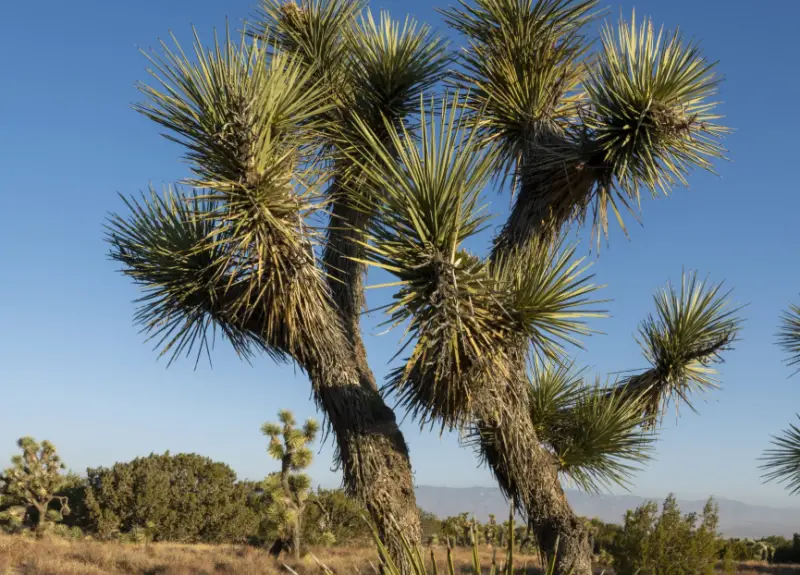Joshua Tree, scientifically known as Yucca brevifolia, is a striking and iconic plant native to the arid landscapes of the southwestern United States. With its unique, twisted branches and spiky leaves, the Joshua Tree has become a symbol of desert beauty.
Whether you’re looking to grow one in your garden or simply curious about this fascinating plant, this guide will provide you with everything you need to know about caring for and cultivating the Joshua Tree.
What is a Joshua Tree?

Overview and Origin
The Joshua Tree belongs to the Agave family (Agavaceae) and is a type of yucca. It thrives in the Mojave Desert, particularly in areas with elevations between 2,000 to 6,000 feet. These trees can live for hundreds of years, with some specimens believed to be over a thousand years old. Their ability to withstand harsh desert conditions makes them a fascinating study in adaptation and survival.
Unique Characteristics
The Joshua Tree is easily recognizable by its thick trunk with fibrous bark, adorned with clusters of sword-shaped leaves at the tips of its branches. These leaves not only help the tree conserve water but also provide protection against herbivores. During the spring, the Joshua Tree produces creamy white, bell-shaped flowers that emit a subtle fragrance. These flowers are pollinated exclusively by the yucca moth (Tegeticula spp.), creating a unique symbiotic relationship. This iconic tree earned its name from Mormon settlers who likened its outstretched branches to the arms of the biblical prophet Joshua, guiding them westward.
Ideal Growing Conditions for Joshua Trees
Climate
Joshua Trees are highly adapted to the arid climate of the desert and thrive in USDA hardiness zones 8 to 10. These regions provide the temperature range and precipitation patterns that mimic their natural habitat. They perform best in areas where daytime temperatures range between 70-95°F (21-35°C) and nighttime temperatures drop significantly, often below freezing during the winter months. Low humidity is crucial for their growth, as excessive moisture can lead to root rot and fungal diseases.
Soil Requirements
The Joshua Tree prefers well-draining sandy or rocky soil that mimics the desert environment. The soil should have low organic matter content, as these plants are accustomed to nutrient-poor conditions. A neutral to slightly alkaline pH level, ranging from 6.5 to 8.0, is ideal for healthy growth. If you are planting in a garden, it is advisable to amend the soil with sand or gravel to improve drainage and mimic its natural habitat.
Sunlight
Full sun exposure is essential for the Joshua Tree to thrive. These plants are accustomed to receiving at least six to eight hours of direct sunlight daily in the desert. Without sufficient light, their growth may become stunted, and they may fail to produce flowers. If you are growing a Joshua Tree indoors or in a shaded area, ensure it receives supplemental light through grow lamps.
How to Grow a Joshua Tree
Propagation Methods
Joshua Trees can be propagated through seeds or offsets. Each method has its advantages and challenges, depending on your level of experience and the resources available.
Propagation by Seeds
Growing Joshua Trees from seeds is a rewarding but time-intensive process. To begin, collect seeds from mature seed pods of an existing Joshua Tree. Once harvested, the seeds should be scarified by lightly sanding their hard outer coat. This process improves water absorption and enhances germination rates. After scarification, stratify the seeds by placing them in moist sand or vermiculite and storing them in the refrigerator for four to six weeks. This step mimics the cold conditions the seeds experience in their natural environment during winter. Once stratified, sow the seeds in a sandy soil mix, covering them lightly. Keep the soil consistently moist but not waterlogged, and be prepared to wait several weeks or even months for germination.
Propagation by Offsets
Joshua Trees produce offsets, also known as “pups,” near their base. These pups can be separated from the parent plant and replanted to grow new trees. To propagate using this method, carefully dig around the base of the offset to expose its roots. Use a clean, sharp tool to separate the offset from the parent plant, taking care not to damage the roots. Allow the offset to dry for a day to form a callus over the cut surface. Once dry, plant it in a well-draining potting mix and water sparingly until new growth appears.
Planting Joshua Trees Outdoors
Planting Joshua Trees outdoors requires careful planning and attention to detail. It is best to plant them in the early spring or fall when temperatures are moderate and less likely to stress the young plants. Choose a location that receives full sun and has well-draining soil. Space the plants six to ten feet apart to accommodate their slow but eventual growth into large trees. When planting, ensure that the base of the trunk is level with the soil surface to prevent water from pooling around the roots, which can lead to rot.
Care Guide for Joshua Trees
Watering
Although Joshua Trees are highly drought-tolerant once established, they require consistent watering during their first one to two years of growth. Young plants should be watered every ten to fourteen days during the growing season, while mature trees need deep watering only once a month during prolonged dry periods. Always ensure the soil has completely dried out between waterings to prevent root rot.
Fertilizing
Joshua Trees generally do not require fertilization, as they are adapted to nutrient-poor soils. However, if the plant is struggling or growing in extremely poor soil, you can apply a balanced, slow-release fertilizer with a 10-10-10 ratio once a year in the spring. Be cautious not to over-fertilize, as excessive nutrients can harm the roots and encourage weak, leggy growth.
Pruning
Pruning is an important aspect of Joshua Tree care, as it helps maintain the plant’s shape and removes dead or damaged branches. Always use sterilized pruning tools to minimize the risk of spreading disease. Remove flower stalks after they have dried and trim dead leaves to improve the plant’s overall appearance. Avoid excessive pruning, as this can stress the plant and slow its growth.
Pest and Disease Management
While Joshua Trees are relatively resistant to pests and diseases, they can occasionally face challenges such as yucca weevils and root rot. Yucca weevils bore into the trunk, causing damage and weakening the plant. To manage these pests, apply neem oil or insecticidal soap as needed. Root rot is typically caused by overwatering or poorly draining soil, so proper watering practices and soil amendments are crucial for prevention.
Joshua Tree in Landscaping
Aesthetic Appeal
Joshua Trees add a dramatic and exotic touch to desert gardens, making them a popular choice for xeriscaping projects. Their sculptural form and striking silhouette make them a focal point in any landscape. Pairing them with rocks, gravel, and other desert elements enhances their visual impact.
Companion Plants
When incorporating Joshua Trees into your landscape, consider pairing them with other drought-tolerant plants that thrive in similar conditions. Cacti, such as barrel cactus and prickly pear, complement the Joshua Tree’s unique form. Succulents like agave and echeveria, along with native wildflowers such as desert marigold and penstemon, create a harmonious desert-themed garden.
Wildlife Habitat
Joshua Trees play an important role in the desert ecosystem by providing shelter and food for various animals. Birds, lizards, and small mammals often use the tree for nesting and protection. The flowers and seeds also serve as a food source for these creatures, contributing to the biodiversity of the area.
Common Challenges When Growing Joshua Trees
Slow Growth
One of the most common challenges for gardeners is the slow growth rate of Joshua Trees. They typically grow only about three inches per year, requiring patience and long-term commitment from those who choose to cultivate them.
Environmental Sensitivity
Joshua Trees are sensitive to extreme cold, frost, and prolonged wet conditions. Young trees are particularly vulnerable and may require protection during cold spells. Using frost cloths or planting in sheltered areas can help mitigate these risks.
Transplant Shock
Transplanting mature Joshua Trees can be particularly challenging due to their extensive root systems. Proper handling during the transplanting process and consistent aftercare are essential to minimize stress and ensure successful establishment.
Fascinating Facts About Joshua Trees
Joshua Trees are deeply embedded in the culture and ecology of the desert. They play a crucial role in the desert ecosystem, providing food and habitat for wildlife. The tree gained international fame when it was featured on U2’s iconic album “The Joshua Tree.” Additionally, the Joshua Tree National Park in California is named after this unique plant, highlighting its cultural and natural significance.
Conclusion
Joshua Trees (Yucca brevifolia) are more than just plants; they are symbols of resilience and adaptability. By understanding their growing requirements and providing the right care, you can enjoy the beauty of this remarkable desert tree in your own landscape. Whether you’re a seasoned gardener or a beginner, cultivating a Joshua Tree is a rewarding experience that connects you to the timeless beauty of the desert.






